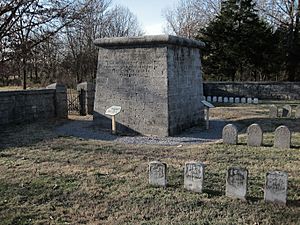Hazen Brigade Monument facts for kids
The Hazen Brigade Monument is a special memorial at Stones River National Battlefield in Murfreesboro, Tennessee. It's the oldest American Civil War monument still standing where it was first built on a battlefield.
The Hazen Brigade's Brave Stand
On December 31, 1862, a big battle called the Battle of Stones River began. Confederate soldiers, led by General Braxton Bragg, launched a surprise attack. They pushed back the Union army, led by Major General William Rosecrans, about three miles.
During this fierce fighting, a group of Union soldiers called Hazen's Brigade held their ground. They were led by Colonel William Babcock Hazen. They defended a small area of cedar trees, about 4 acres big, known as the Round Forest. This spot was very important for the Union army's defense.
Hazen's soldiers, helped by other Union troops and powerful cannons, fought bravely. They stopped four attacks from the Confederate army. The fighting was so intense that soldiers called this place "Hell's Half-Acre."
Hazen's Brigade suffered many losses. Out of their group, 409 soldiers were hurt or killed, including 45 who died. Their strong defense kept the Confederate army from breaking through the Union lines. Many believe their courage saved the Union army from a major defeat.
Building the Monument
In the summer of 1863, while the war was still going on, Hazen's Brigade built this monument. They wanted to remember their brave actions and honor the soldiers who died. A team led by Lieutenant Edward Crebbin placed the monument in a cemetery for the brigade.
A Union army captain described the monument. It was a pyramid shape, ten feet wide at the bottom and eleven feet tall. A stone wall, four feet high, surrounded both the monument and the cemetery. There were three steps to enter the area.
In 1864, two skilled stone cutters from the regiment carved words into the monument. They wrote the names of officers who died at Stones River and an earlier battle called Battle of Shiloh. On one side, it says: "HAZEN'S BRIGADE / TO THE MEMORY OF ITS SOLDIERS WHO FELL AT STONES RIVER, DEC. 31ST 1862 / THEIR FACES TOWARDS HEAVEN, THEIR FEET TO THE FOE."
Later Years of the Monument
The land where the monument stands became part of the War Department in 1875. For many years, it was looked after by the Stones River National Cemetery. During this time, the monument sometimes suffered from neglect and damage.
In 1930, the Hazen Monument and the National Cemetery became part of the Stones River National Military Park. Then, in 1933, the National Park Service (NPS) took over its care. The NPS still looks after it today.
In 1907, a writer named Ambrose Bierce visited the monument again. He had been a soldier in Hazen's Brigade and fought at Stones River. He knew Colonel Hazen well. Bierce wrote a mysterious story called "A Resumed Identity" in 1908. In the story, the Hazen Monument plays a key part in a surprising ending.
Bierce described the monument as it looked in 1907. He said it was "brown with age, weather-worn at the angles, spotted with moss and lichen." He also noted "strips of grass" between the large stone blocks.
In 1985, workers repaired the monument. They found several objects inside its stone and soil filling. Some items were bullets, cannonballs, and musket barrels. These items were placed at a single level, leading the National Park Service to believe they were put there on purpose. It was like a hidden time capsule, though no one knows for sure what message it was meant to send.



